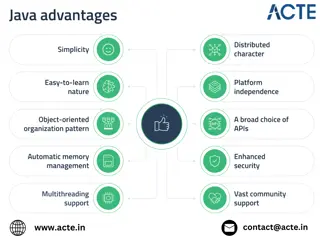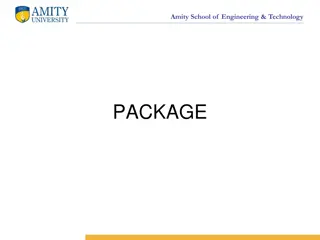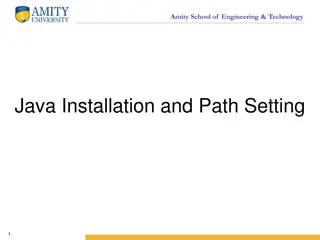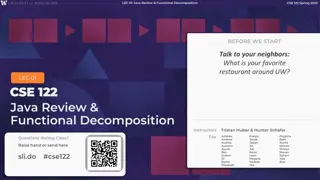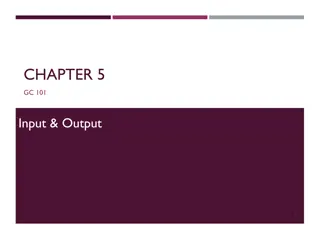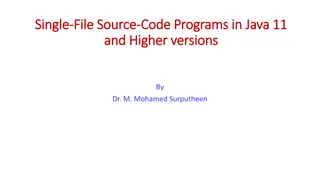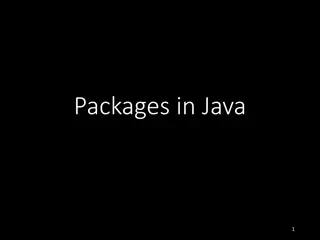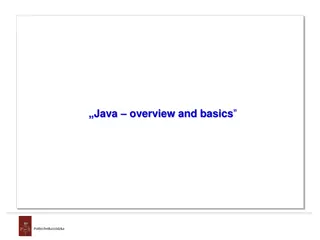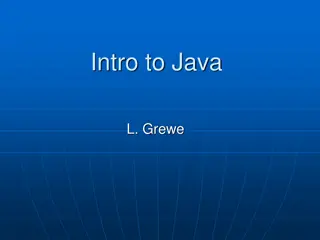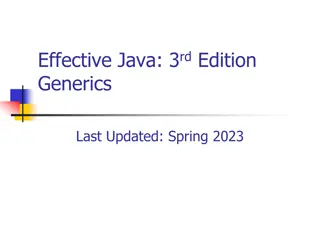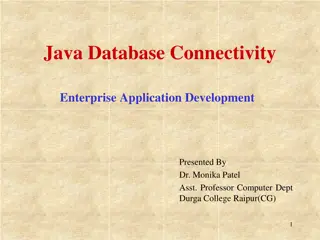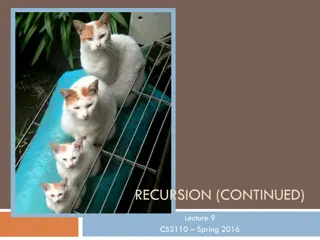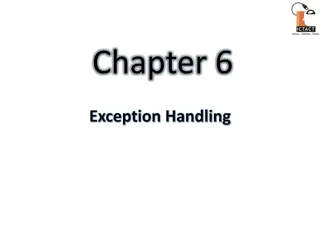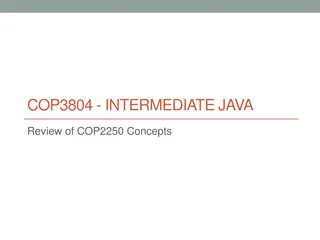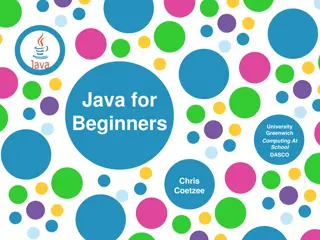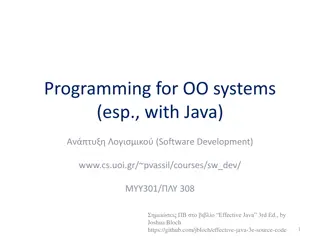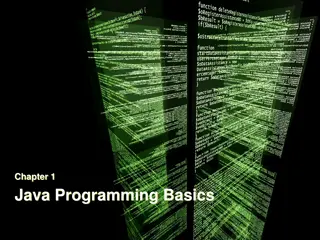
Introduction to Programming in Java: Basics and Structure Explained
Learn the fundamentals of Java programming, including the structure of Java programs, compiling, running programs, and printing messages. Explore the reasons for using programming languages over natural languages and get an overview of creating, compiling, and executing Java applications.
Download Presentation

Please find below an Image/Link to download the presentation.
The content on the website is provided AS IS for your information and personal use only. It may not be sold, licensed, or shared on other websites without obtaining consent from the author. If you encounter any issues during the download, it is possible that the publisher has removed the file from their server.
You are allowed to download the files provided on this website for personal or commercial use, subject to the condition that they are used lawfully. All files are the property of their respective owners.
The content on the website is provided AS IS for your information and personal use only. It may not be sold, licensed, or shared on other websites without obtaining consent from the author.
E N D
Presentation Transcript
Contents for Todays Lecture Structure of Java programs Compiling and running the program Printing messages to the screen
Some Basics Definition of a program? A sequence of instructions that a computer can interpret and execute. Why don t we just use natural languages such as English? A computer is not intelligent enough to understand natural languages.
Structure of Java Programs class-name.java class class-name { public static void main(String args[]) { statement1; statement2; } }
A statement written in Java println( Hello World!"); every statement is every statement is terminated with a terminated with a ; String hello = Hello World!"; println(hello); 5
Example Program First.java public class First { public static void main(String args[]) { System.out.println( Hello World ); statement statement } }
Creating and Compiling Programs Create/Modify Source Code On command line javac First.java Source Code Compile Source Code i.e. javac Welcome.java If compilation errors Bytecode Run Byteode i.e. java Welcome Result If runtime errors or incorrect result 7
Executing Applications On command line java classname Bytecode Java Java Java Interpreter on Windows Interpreter on Linux Interpreter on Sun Solaris ... 8
Example javac First.java java First output:... 9
Compile and run java command line Compile javac file-name.java Run java filename Example: HelloWorld.java Compile javac HelloWorld.java Run java HelloWorld
Compiling & Running the Program Compiling: is the process of translating source code written in a particular programming language into computer-readable machine code that can be executed. > javac First.java This command will produce a file First.class , which is used for running the program with the command java . Running: is the process of executing program on a computer. > java First
Example Program second.java class second { public static void main(String args[]) { System.out.println( Hello World ); } } Compile javac second.java Run java second
Example Program HelloWorld.java class HelloWorld{ public static void main(String args[]) { System.out.println( Hello World ); } } Compile javac HelloWorld.java Run java HelloWorld
About Printing on the Screen 1. System.out.println( Hello World ); outputs the string Hello World followed by a new line on the screen. 2. System.out.print( Hello World ); - outputs the string Hello World on the screen. This string is not followed by a new line. 3. Some Escape Sequence \n stands for new line character \t stands for tab character
Java print() and println() Text can be printed on the screen using print() or println(). Using println() puts a new line at the end of the text. print("7*3"); println("="); println(7*3); This code prints: 7*3= 21 15
Example Welcome.java public class Welcome { public static void main(String args[]) { System.out.print("Welcome "); System.out.println("to"); System.out.println( java!"); } } } } Welcome to java! Output
Example Welcome3.java ( includes \n and \t) public class Welcome { public static void main(String args[]) { System.out.print("Welcome \n "); System.out.print("to \t"); System.out.println( java!"); } } } } Welcome to Output java!
Some Tips About Programming Some common errors in the initial phase of learning programming: - Mismatch of parentheses - Missing ; at the end of statement - Case sensitivity Writing programs on your own is the best way to learn how to program.
Comments in java There are two ways of commenting code. Comments starting with // and terminated by end of line // Lahcen Ouarbya // 1 October 2012 // Hello World Comments enclosed in /**/ /* Lahcen Ouarbya 1 October 2012 Hello World */ good to make several good to make several lines of comments stand lines of comments stand out in your program out in your program 19
Concatenating output with + print("I like programming in "); println("Java"); This code prints: I like programming in Java print("I like programming in + Java ); This code prints: I like programming in Java 20
Example Concatenate.java public class Concatenate { public static void main(String args[]) { System.out.print("I like programming in "); System.out.println( java"); System.out.println("I like programming in + java ); System.out.println( square root of 4 = + 2 + " or + -2); } } I like programming in java I like programming in java square root of 4 = 2 or -2 Output
Example Welcome.java public class Welcome { public static void main(String args[]) { System.out.print("Welcome "); System.out.print("to "); System.out.println("Java!"); System.out.println( Welcome + "to + " Java!"); } } } Output Welcome to java! Welcome to java!
Exercise 1. Write a program which prints your name and Student ID. 2. Write a program that prints the multiplication table of 5.
summary HelloWorld.java Compile and run java programs. print/println \n new line \t tab Concatenation
More practice exercises. Introduction to Java and Object Oriented Programming (Volume 1) 1. Chapter 2. After todays Lecture you should be able to complete all exercises In Section 2.10, page 14. 2. Chapter 3 If you are confident with all the material in Chapter 2, then start Reading Chapter 3. 3. Extra More practise exercises are on page: http://introcs.cs.princeton.edu/java/11hello/


